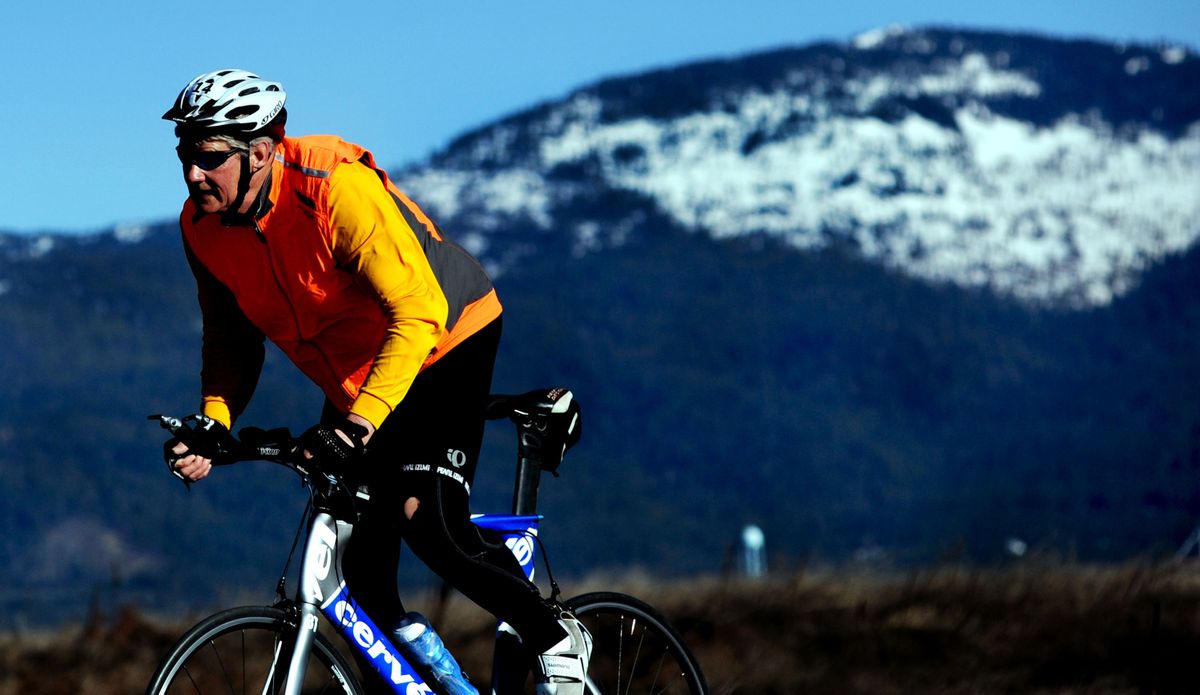Bike gives Aylward a leg up as Ironman nears

Tom Aylward speeds off on his bike into the Rathdrum Prairie wind, accelerating quickly, determined not to let his training partners catch him.
In the past month, the 62-year-old’s biking has improved so much it could become his saving grace when the Ford Ironman Coeur d’Alene hits June 26.
The Spirit Lake man has been training almost two years for the race, but a painful nerve irritation in his left foot has limited his running miles.
The Ironman starts with a 2.4-mile lake swim, transitions to a 112-mile bike ride and ends with a marathon – 26.2 miles.
“I’ve had one doctor and three physical therapists working on my foot and it’s not any better,” said Aylward. “We are just going to get through this any way we can. Nobody promised me any miracles. It’s just the way it is. I’m just accepting it.”
During Wednesday’s workout, Aylward and his three training partners chased each other around five loops consisting of 6.7 miles of biking followed by 1.3 miles of running. Around the fifth mile of running, Aylward’s foot pain kicked in. But during his second biking loop, he passed one of his training partners.
Another of the athletes, Karin Walker, said Aylward “kills me on the bike. He’s got weight and size on his side.” Aylward is 6-foot-4 and weighs 239. He’s lost 80 pounds since he began training in August 2009.
Aylward ran Bloomsday, knocking 20 minutes off last year’s time, and completed a 13-mile training run on May 9, but pain still radiates through his metatarsals when he hits the pavement.
His trainer, Shawn Burke, wanted him to run 10 miles Monday. “I tried,” Aylward said. “I could only give him 2 ½.” He ran five miles Tuesday morning but said, “Maybe one mile out of the four was good.”
Aylward is resigned to the fact that he is going to be in pain during the run, but Ironman’s structure should work in his favor. His swimming and biking have become so strong that even if he has to walk part of the marathon, he should still finish in the 17 hours allotted.
Ironman contenders jump into the water at 7 a.m. and have 2 hours and 20 minutes to finish the swim. They have to finish the bike segment by 5:30 p.m, and the first 13-mile loop of the marathon by 9 p.m. They have until midnight to cross the finish line although there is a 10:45 p.m. cutoff at about mile 20.
“If you swim it in two hours and bike it in six, you’ve still got nine hours,” said Mac Cavasar, race director. “It’s a perseverance situation. There are a lot of people who just walk (the marathon). There’s no shame in that.”
When the training group began its Wednesday morning “chase downs” a few weeks ago, Aylward said, the others always caught him. But they don’t catch him much anymore. And he frequently doesn’t feel tired after the workout. In addition, he discovered that standing on his pedals when biking uphill gives him strength and speed, which boosted his confidence. He’s completed several 60- to 70-mile bike rides within the past month, all within his desired time range.
“We’re getting faster every week,” Aylward said. “It’s time to quit worrying about it. I’m just going to be OK.”
Though Aylward’s weight has continued to plateau at 239, he was thrilled to discover he’d dropped 10 pant sizes when he bought shorts recently. When he first began training 22 months ago, he had a 50-inch waist; now it’s 40.
Burke, who has completed 17 Ironman races, said a “big negative” this year has been the cold spring, which has delayed the warming of Lake Coeur d’Alene. Completing some open-water swims, as opposed to training in a pool, is a confidence-builder that has been postponed, Burke said.
“That makes me nervous,” he said.
Aylward signed up for a lake swimming class that begins Thursday night and will be held once a week until race day.
In recent weeks, Aylward has struggled mentally, alternating between the highs that come from good workouts and the lows of his running troubles, as the clock ticks down the days. He is intimately aware of how many days remain before the race.
Burke’s training program has Aylward working out 18 to 20 hours per week, three to four hours per day, with rest days following big workouts. Seven to eight hours would be the maximum workout on a given day. As an athlete gets stronger, the idea is to build strength, allow the body to recover, then repeat, Burke said.
Burke, who has learned to read Aylward in the time they’ve worked together, said the “unknown” is getting to his client, as it does with many first-time competitors. Athletes unfamiliar with the race need to know that short tempers, along with feelings of doubt and frustration, are normal this close to the race, he said.
Burke has encouraged Aylward to find activities that take his mind off the race. “Read a book, go sit by the lake,” he said. “You can’t let this thing control your whole life.”
Aylward is a caring person who frequently sacrifices his own needs to help others, but now he needs to be selfish and focus on himself so he can complete this goal he’s worked toward so hard and so long, Burke said.
“He has definitely made some good gains. He is doing actually better at this point than I thought he was going to do,” Burke said. But, he said, “He is like a roller coaster – it becomes a mental thing with him.
“The base is there,” Burke said. “Now it’s taking him to that next level.”